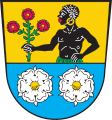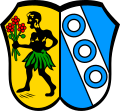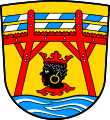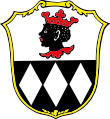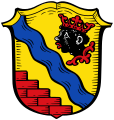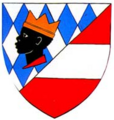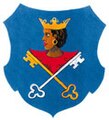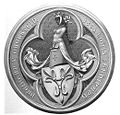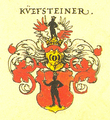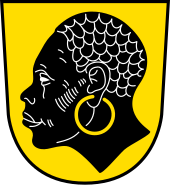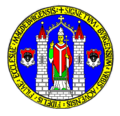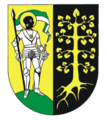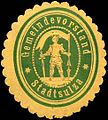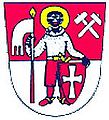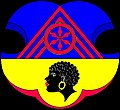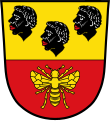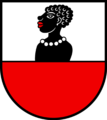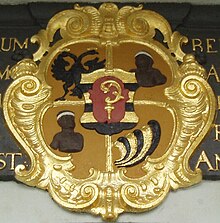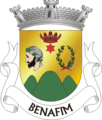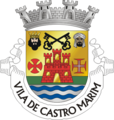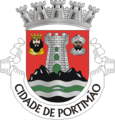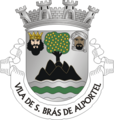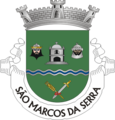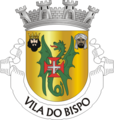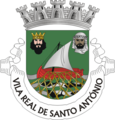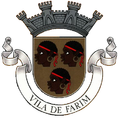Mohr (heraldry)
The moor as a coat of arms was introduced into heraldry early on and is referred to as a common figure . The Mohr is represented in many coats of arms and in the upper coat of arms . Examples are the coat of arms of Pope Benedict XVI. , the Hochstift Freising or the coat of arms of the Pappenheimers .
A human figure or parts of it are represented, especially the head. The black color scheme is chosen to identify a dark-skinned person. Male and female persons are included in the coat of arms, and these often have blonde, i.e. golden, but also short black, strongly curled hair. They can be crowned and appear, for example, in the upper coat of arms as dudes or in the trunk . In many cases the Mohr was a symbol of Saint Mauritius , including patron saint of the army and the armory, whose patronage many churches were consecrated in the Middle Ages. In some cases, however, there are also specific sagas, legends or historical events behind the coat of arms symbol.
The crowned Mohrin in the coat of arms of the Kirchbergers and Fuggers (14th century)
An old coat of arms of the Swabian line of the Counts of Kirchberg already shows a crowned female figure (virgin) with a presumably three-flowered flower (rose, lily or thistle) in her hand, which at that time stands as a symbol of the Trinity , which is why a reference to Mary seems possible . On a seal of Count Konrad von Kirchberg on a document from the Wiblingen Monastery from 1313, the crowned virgin holds a ball in her right hand. In 1355 she was first shown in color as Mohrin in the Zurich coat of arms .
With the Kirchbergers, the Mohrin received a bishop's cap instead of a "black hat" at the latest from the 15th century, first instead of the crown on her head, then in her hand. It appears that this was the result of Eberhard von Kirchberg after he became Bishop of Augsburg in 1407.
1488 Illertissen is by Emperor Friedrich III. a coat of arms based on that of the local lords of the time, the Counts of Kirchberg, awarded. This showed a black-clad Mohrin with a black bishop's cap on her head, in her right hand a green branch with three leaves, but here with three thistles. The Counts of Kirchberg died out in 1520, and Illertissen soon received the coat of arms of the new landlord.
After the Fuggers acquired the county of Kirchberg and the dominions of Weißenhorn, Wullenstetten, Pfaffenhausen and the remains of the former county of Marstetten in 1507, the coat of arms of the Counts of Fugger von Kirchberg and Weißenhorn also shows the Kirchberg Mohrin with miter.
A woman with a miter also shows the coat of arms of: Oberkirchberg since at least 1555 (but not yet as Mohrin), Unterkirchberg , the community of Illerkirchberg and the district of Neu-Ulm, formed from these two districts .
Kirchberg coat of arms in the Zimmerische Chronik (mid-16th century)
Further Mohrinnen coats of arms of Friedrich III.
Before the arms of Illertissen (1488), Emperor Friedrich III. further coats of arms with a Mohrin were awarded.
Innsbruck, Vienna, Regensburg (15th century)
As early as December 17, 1442, Friedrich had given the Innsbruck Sigmund Rukenhauser a coat of arms on which “ain swarcze Morin bisz an die prust with a yellow plaited braid” was depicted. On July 5th, 1471, he issued a letter of arms to Georg Swab von Burgbernheim in Regensburg. Both in the shield and on the helmet there is a bust of a Moor. On February 28, 1472 he gave a coat of arms to Claus Newffer, on which "ain barhawbte morin, becleidt in weyss had in ir yeder hand also an upright yellow salczschewfl and umb ir hawbt a pounding pound, blab and weysz" could be seen. On March 10th of the same year, Sebald Schreyer and his father Hanns Schreyer received a coat of arms with a "morin on fusz and on arm, in swarcz clothed in front with three yellow locked yellow belts gollir harpannt a swarczn plaited plait and a yellow ring in the oren." In 1487, Hans and Lorenz Mordeisen received a Moorish coat of arms.
The Mohr or Möhrin from Tuttlingen-Möhringen (15th century)
That of Emperor Friedrich III is still relevant today. Coat of arms awarded to the former city of Möhringen an der Donau in 1470 . Möhringen has been a district of Tuttlingen since 1973 . Allegedly the Möhringer made a female figure out of it in the 19th century, the Mohrin, who is popularly referred to as "Möhrin" based on the place name. But in view of Friedrich III. it is possible that it was originally a Mohrin. Cast in ore, life-size adorns the pike fountain in the center of the village.
The former coat of arms of the neighboring town of Seitingen, which was in effect until 1977, is related to this .
The Mohr in the coat of arms of Wolffskeel and Grumbach (14th century)
Wolffskeel'scher Mohr : The coat of arms of the noble Wolffskeel family shows a Mohr walking to the left with three red roses. It appears for the first time with the Würzburg Prince-Bishop Wolfram Wolfskeel von Grumbach (1322-1333). According to tradition, it is St. Mauritius .
The tombstones of Bishop Wolframs and his nephew Otto II von Wolfskeel († 1345), who succeeded him as Bishop of Würzburg in 1333, can be seen in the Würzburg Cathedral . His coat of arms bears two Moors, one to the right and one to the left.
Two more tombstones are now in the Mainfränkisches Museum:
- Eberhard von Wolfskeel († 1379)
- Friedrich von Wolfskeel († 1408)
Grumbach'scher Mohr : The Grumbachs are of the same origin as the Wolfskeels and initially had the same coat of arms.
The Mohr can also be found in the coat of arms and thus on the ceremonial sword and on coins of the Würzburg Prince-Bishop Johann III. von Grumbach (bishop from 1455 to 1466). When the Wolfskeels demanded a change of coat of arms in order to be able to differentiate themselves from the soon unpopular Grumbachs, the Roman-German King Maximilian I stipulated in 1492 that the Mohr der Grumbacher should walk to the left and the Mohr der Wolfskeels to the right.
The Mohren coat of arms can also be found on the tombs of the following Grumbach aristocrats, mostly made by Riemenschneider :
- Eberhard von Grumbach († 1487)
- Konrad von Grumbach († 1526)
- Hans von Grumbach-Estenfeld († 1529)
- Wilhelm von Grumbach (1503–1567)
Several other local coats of arms of former Wolffskeel and Grumbach possessions therefore also show such a Moor.
The Mohr from Uettingen and the Mohr from Unterpleichfeld , for example, depend on this .
Until 1974 the Wolffskeel'sche Mohr was also part of the coat of arms of the Würzburg district
Coat of arms of the von Wolfskeel family based on Johann Siebmacher's coat of arms book
Coat of arms of Uettingen with the Wolffskeelschen Mohr
Coat of arms of Unterpleichfeld with the Wolffskeelschen / Grumbachschen Mohr
The crowned Mohr of Freising (13th century)
Freisinger Mohr : The diocese of Freising and the district of Freising also have a " Mohr " in their coat of arms. The crowned African ("caput aethiopis") appeared for the first time in 1284 in the coat of arms of Bishop Emicho Wildgraf von Wittelsbach (1283-1311). The title “Wildgraf von Wittelsbach” hides the fact that he is descended from the Kyrburg family on his father's side and from the Kirchberg family through his grandmother . His uncle Konrad was already Bishop of Freising († 1278), so a reference to the Kirchberg coat of arms is obvious.
According to legend, however, previous bishops, in particular Bishop Otto von Freising (1112–1158) , were given the Mohr in their coat of arms during his participation in the Second Crusade . Otto was the son of the holy Babenberger Leopold III. , Margrave of Austria, and the daughter of Emperor Heinrich IV. , Agnes von Waiblingen , and thus grandson of Emperor Heinrich IV. And uncle of Emperor Friedrich Barbarossa . He received his first training in the monastery of Klosterneuburg , which his father founded in 1114. In 1126 he was appointed provost of the monastery, which is why a reference to the Verdun Altar with the Queen of Sheba seems possible. At the end of the 15th century he was naturally assigned a Moor on a wall painting in Klosterneuburg. In 1586 the painter Stephan Andreas Mayr assigned him a coat of arms with two moors. This picture is also in Klosterneuburg.
According to a widespread interpretation, however, the Mohr emerged from the misinterpretation of a representation on which actually simply a crowned head was depicted, with which Bishop Emicho wanted to indicate the imperial immediacy of his area. It is conceivable that it was actually a portrait of Rudolf von Habsburg or Emicho himself. Another possible derivation is the reference to a location in the Acts where an Ethiopian Chamberlain of the Acts Philip is christened (Acts. 8.26).
In the year 1316 he was then in colored version - clearly as "Mohr" - on the cover of the house and notebook of Bishop Konrad III. (1314-1322) shown. In 1340 it can already be found in the Zurich coat of arms under the diocese coats of arms. Until the dissolution of the Hochstift Freising in 1803 it was permanently on the coat of arms of the bishops of Freising. From 1846 the new Archdiocese of Munich-Freising was allowed to wear the Moor again in its coat of arms.
Even Sebastian Münster Cosmographie Universalis with Freisinger cityscape of 1550 wearing a coat of arms that shows two arms quarters Moors, but different with two faces.
Coat of arms of the former Pope Benedict XVI.
Community and district coats of arms dependent on Freising
Numerous cities and towns that used to belong to the Freising Monastery have coats of arms with the "Freising Mohr".
Coat of arms of the Freising district
Coat of arms of the municipality of Eching (Freising district)
Coat of arms of Fahrenzhausen (Freising district)
Coat of arms of the municipality of Zolling (district of Freising)
Coat of arms of the Garmisch-Partenkirchen district
Coat of arms of the Mittenwald community (Garmisch-Partenkirchen district)
Coat of arms of the municipality of Pastetten (district of Erding)
Coat of arms of the municipality of Wörth (district of Erding)
Ismaninger coat of arms (district of Munich)
Unterföhringer coat of arms (near Munich)
Coat of arms of the municipality of Huisheim (Donau-Ries district)
Coat of arms of the statutory town Waidhofen an der Ybbs (Lower Austria)
Coat of arms of Groß-Enzersdorf (Lower Austria)
Coat of arms of Neuhofen an der Ybbs (Lower Austria)
Coat of arms of Oberwölz city (Styria)
Coat of arms of Sankt Peter am Kammersberg (Styria)
The Mittenwald coat of arms is of particular interest because it offers a frontal portrait of a Moor's head in its early form. It was awarded in 1407 by the Freising Bishop Berthold von Wehingen .
Additionally in Lower Austria :
- Hollenburg (municipality of Krems) (Lower Austria).
- Ulmerfeld (Lower Austria).
Styria :
- Oberwölz (Styria).
- Sankt Peter am Kammersberg (Styria).
Slovenia :
- Dovje .
- Klevevz .
- Severna Istra .
- Škofja Loka .
Episcopal coats of arms dependent on Freising
Many Freising bishops have adopted the Moor in their coat of arms, for example:
- Bishop Conrad III. the Sendlinger (1314–1322)
- Bishop Nicodemus della Scala (1421–1443)
- Bishop Johann IV. Tulbeck (1453–1473)
- Bishop Philip of the Palatinate (1498–1541)
- Prince-Bishop not yet identified
- Prince-Bishop Albrecht Sigismund of Bavaria (1652–1668)
- Prince-Bishop Johann Franz Eckher von Kapfing and Liechteneck (1694 / 95–1727)
- Prince-Bishop Cardinal Johann Theodor of Bavaria (1727–1763)
- Prince-Bishop Clemens Wenzeslaus of Saxony (1763–1768)
- Prince-Bishop Maximilian Prokop von Toerring-Jettenbach (1788–1789)
- Cardinal Francis von Bettinger (1909-1917)
- Cardinal Michael von Faulhaber (1917–1952)
- Cardinal Joseph Wendel (1952–1960)
- Cardinal Julius Döpfner (1961–1976)
- Cardinal Joseph Ratzinger (1977-1982). He also adopted the Moor in his coat of arms as a curia cardinal and finally as Pope Benedict XVI. in his papal coat of arms .
- Archbishop of the Curia Georg Gänswein (2012-date) (as a close collaborator of Benedict XVI.)
- Cardinal Friedrich Wetter (1982-2007)
- Archbishop Reinhard Marx (2008-date)
- Auxiliary Bishop Wolfgang Bischof (2010-date)
The Mohrenlöwe from Abfaltersbach

The Mohr lion is a two-part fictional heraldic figure in which the upper body of a Moor is combined with the abdomen of a lion. The Mohr is dependent on the Freising coat of arms.
The crowned Mohr of Lauingen (15th century)
Lauinger Mohr : In Lauingen ( Swabia ) there is already an old seal from 1270 in the city archives that shows a man's head with long hair, a beard and a temple crown, which according to tradition is supposed to be Friedrich Barbarossa . In 1451 the head, which has changed several times since then, turns to the right into profile. For the first time, a Moor's head with a necklace, earring and wall crown can be clearly seen. Besides Eisenberg, Lauingen is also the city that is often referred to as the Mohrenstadt .
A legend painted in the courtyard tower of the city of Lauingen, on the other hand, reports for the 10th century: At the time when the heathen or Huns had advanced as far as Swabia, the emperor and his army advanced against them and camped not far from the Danube between Lauingen and Faimingen Castle . After several unsuccessful attacks on both sides, Christians and pagans finally agreed to let the dispute be resolved by a duel. The emperor chose Marshal von Calatin (Pappenheim) as his fighter, who gladly accepted the assignment and pondered how he would certainly like to achieve victory. Meanwhile an unknown man came up to him and said: “What are you thinking? I tell you that you shouldn't fight for the emperor, but that a shoemaker from Henfwil (later Lauingen) is chosen. "The Calatin replied:" Who are you? How should I refuse the honor of this fight from myself? ”-“ I am George, Christ's hero ”, said the stranger,“ and take my thumb as a symbol. ”With these words he pulled the thumb from the hand and gave it to the marshal who went to the Emperor without delay and related the whole incident. It was then decided that the shoemaker should fight the pagan. The cobbler took over and happily defeated the enemy. Then the emperor gave him the choice of three graces to ask. First, the shoemaker asked for a meadow near Lauingen so that it could be given to the city as a common property. Second, that the city should be sealed with red wax (which no other indirect place was allowed). Thirdly, that the Lords of Calatin should have a Mohrin as a helmet jewel. Everything was granted to him and St. George's thumb was carefully kept by the Pappenheimers, half of which were set in gold at Kaisheim, the other half at Pappenheim.
This legend suggests that the Lauinger Mohren is also a Mohrin and that the coat of arms is directly related to the Pappenheim coat of arms. Already in the Swabian Chronicle of Martin Crusius from the years 1595/96 it is reported that Emperor Otto I put the black Mohrenkopf of the Calatinen in the coat of arms of Lauingen and is said to have allowed the Calatinen to lead only one Mohrin.
Heinrich von Morungen (14th century)
The Weingartner song manuscript from the first half of the 14th century assigns a Moor coat of arms to the minstrel Heinrich von Morungen († around 1220 in Leipzig ). This could be identical to the Hendricus de Morungen attested in Thuringia , who belonged to the lower knighthood and probably came from Morungen Castle near Sangerhausen .
The Mohr and the Crowned Mohrin von Pappenheim (14th century)
Pappenheimer Mohr and Pappenheimer Mohrin
The city coat of arms of Pappenheim shows a Moor's head with curled hair and a forehead band. The Pappenheim marshals included this figure in their crest. The head of Hieron II of Syracuse can be found on the oldest (1251) seals of the marshals . A coin with this male head from pre-Christian times served as a model. She wears a forehead band on a city seal in 1335. Due to an imprecise reproduction, the original representation, which was taken as the emperor's head, and since its colors were black on gold, turned into a moor's head, as shown on a seal in 1378, with a high three-pointed crown on the rather grimaceous face.
It is interesting that in the 15th century - in accordance with the legend mentioned above about the crowned Mohren von Lauingen - a female upper body was added to this head, which in the 16th century had a plait or two protruding plaits and later became a Mohrin.
The Mohrin von Graefenthal
The Mohrin in Gräfenthal's coat of arms also goes back to the Reichserbmarschalls von Pappenheim, who held the manor from 1438 to 1621.
Coat of arms with a Mohr or a Mohrin in the crest
In addition to the Pappenheimers and some patrician families, there is also a Mohr or Mohrin in the crests of other coats of arms. This is very often associated with a Moorish princess through the associated heraldic legends.
Bentheim-Tecklenburg
The tribe crest of this Westphalian Uradelsgeschlechts shows a Mohr hull with red pointed cap.
Mohrin in the coat of arms of the Barons von Eberstein (15th century)
The coat of arms of the Ebersteiners has been adorned by an open tournament helmet since around the 15th century, which in turn wears a white-clad, gold-crowned Mohrin without arms as a helmet attachment with a white head band ( cinder band ) in the oriental style. Sometimes the view was taken that this element came from a Moorish princess captured during the crusades. Since the Ebersteiners had been vassals as marshals of the Würzburg bishopric since 1303, following an appeal, they too submitted the coat of arms to their fiefdom in 1540. Nevertheless, as before 1540, later - especially in the Gehofener line - there is still a pigtail instead of the white head bandage or even blowing hair and a blue one instead of the white dress.
Eberhard von Eberstein, 1451, to the right turned
Family coat of arms according to Johann Siebmacher's coat of arms book , 1605, turned to the right
The Mohrin der von Loeben
The noble family Loeben is an old Silesian noble family. The family was first mentioned in a document in 1253. The coat of arms legend reports that the family received their coat of arms from the Moorish queen Pelusa of Meroe as early as 733 .
The Mohrin of those of Prittwitz
Prittwitz is the name of an old, very widely branched Silesian noble family . It was first mentioned in a document in 1283. According to the heraldic saga, it is a Moorish princess.
The Mohrin der von Sack
The Silesian-Saxon noble family Sack - sometimes also called Säcke - has a bust of a naked Moorish maiden wearing a wreath of red and white roses over her long hair in the helmet of the coat of arms . According to the saga of the coat of arms handed down by Johann Sinapius , they are said to be “from the tribe father, a belligerent German soldier who, in ancient times, under a king in Spain during the war, once again stole a good portion of food in sacks from the Moors due to a lack of provisions , the sacks and the Mohren image in the coat of arms, also afterwards the gender name de Sacco or von Sack have come from there. "
Coat of arms in Siebmacher's coat of arms book
The Mohr from Kuefstein (late 16th century)
The coat of arms of the Austrian noble family Kuefstein from the year 1599 shows a naked Moor with a gold crown and sword standing on a yellow hill in a red field. In addition, in the crest a moor between two divided eagle wings. This is also retained in the later count's coat of arms. The coat of arms is associated with participation in a crusade.
The Moors of the von Seydewitz
The noble family Seydewitz belongs to the Meissen prehistoric nobility and is mentioned in a document in 1299. The oldest known coat of arms shows the three Moors. In the Thuringian line in 1497 in the seal of Michel von Seydewitz auf Crostewitz in the helmet the head and neck of a Moor can be found in profile. The background is St. Mauritius suspected.
The Mohrenkopf from Saalhausen
The coat of arms of those of Saalhausen shows a dragon's head on the back of which a Moor's face is depicted. It is probably the only coat of arms in Germany that shows a double-headed combination of mythical creatures and humans. It was based on the anecdote that an ancestor in the Mohrenland protected his master from a dragon attack.
The Moor of Schauenstein (17th century)
Schauensteiner Mohr : In the first surviving colored drawing of the coat of arms of Schauenstein ( Upper Franconia ) from 1581, the previously traditional man is black and holds up a small red stone. It is clearly a miner with a lump of ore in hand to illustrate the place name: a stone on display. Since 1692 the miner has been misinterpreted as a Moor. From 1812 the man is depicted naked with a piece of meat in his hand; there are also pictures of the Moor holding a mirror.
Mauritius coat of arms
The Moor of Coburg (late 15th century)
The coat of arms of Coburg also shows a "Moor" . It is very likely a representation of the city's patron saint, Saint Mauritius , because the oldest church in Coburg changed from a Stephanskirche to a Morizkirche between 1150 and the beginning of the 14th century . From 1380 a mint master from Coburg also had a Moor's head as a master's mark. In 1430, Saint Mauritius became the patron saint of the city - probably in the course of the Hussite invasions - and has been on the city's coat of arms ever since. In 1493 the word "Mohrenkopf" appeared for the first time in old files, when a tin master was obliged by the city to mark his wares with the Mohrenkopf in addition to his maker's mark. The oldest imprint of the city seal with the Mohrenkopf comes from the year 1521. In 1575 he was carved together with the lion on a stone shield of the Coburg town hall.
On April 30, 1934, the city coat of arms was removed by the National Socialists and replaced by a coat of arms with a sword . From August 6, 1945, the former city coat of arms was used again, which was changed in form in 1953 and became legally binding with this standardization.
Today there is Mohrenstrasse , which was laid out at the end of the 19th century, and was known as the Strasse der SA from 1937 to 1945 , with the Mohrenbrücke .
"Coburger Mohr" is u. a. the name of a dance sports guard of the Coburg carnival, also a Coburg city magazine and a pharmacy are named after the Moor.
The Mohr of Zwickau (16th century)
Zwickauer Mohr : The patron saint of Zwickau is St. Mauritius, after he was mentioned as the patron saint of the parish church in 1212. Since 1560 he adorns the so-called "Great Coat of Arms" or "Des Council Whole" as a Moor.
The Mohr von Aken on the Elbe
St. Mauritius as a Mohr can also be found in the coat of arms of Aken on the Elbe . This results from the close connection to Magdeburg , of which Aken was even the immediate city of the Magdeburg Duchy from 1680 .
The Mohr from Bad Sulza
Sulzener Mohr : The coat of arms of Bad Sulza from 1907, the holy place in Mauritius armor, which the municipal merger with village Sulza from the arms City Sulzas was acquired. In contrast to before, he is shown as a Moor. St. Mauritius can already be found in the oldest known seal from 1567 with a flagged lance in hand. He was probably accepted as the patron saint of salt boilers .
The Mohr von Förderstedt
Förderstedt , today part of the city of Staßfurt in the Salzlandkreis in Saxony-Anhalt, had Saint Mauritius in the municipal coat of arms accompanied by a crossed silver mallet and iron. It points to the connection between the place and the cathedral chapter of Magdeburg and was already included in medieval court seals.
The Mohr from Krautheim
The city coat of arms of Krautheim shows under the silver head with three green linden leaves in the split shield a silver mill wheel in front in blue and behind the black Mohrenkopf in gold, which represents the city patron Mauritius. The city patronage comes from the St. Mauritius, first mentioned in 1140 and belonging to the Naumburg Moritzkloster.
The Moor of Bevensen-Ebstorf (21st century)
The integrated community of Bevensen-Ebstorf , which was formed on November 1, 2011, has St. Mauritius recorded as a Mohr as a reference to the mid-12th century founded and dedicated to St. Ebstorf Monastery consecrated to Mauritius .
The Mohr from Sandau
Around 1361, the city of Sandau was obliged by Emperor Karl IV to take the oath of homage to the archbishopric of Magdeburg and to include its coat of arms and patron saint in the seal, see coat of arms of the city of Sandau (Elbe) .
Court seal of the cathedral provosts of Magdeburg
Since Heinrich VII, Count von Stolberg, provost of the cathedral and elected (archbishop) in Magdeburg since 1323, the seal of the provosts in general shows St. Mauritius. From there, St. Mauritius probably also in the seal of the towns associated with the Magdeburg cathedral chapter, cathedral provost and archbishopric, verifiably in Aken, Förderstedt and Sandau also as "Magdeburger Mohr" (around 1250) in Magdeburg cathedral .
The Moor of the Blackheads Guild
In Livonia , e.g. B. in Riga and today's Tallinn , there were branches of the so-called “Compagnie der Blackheads” (also known as the Blackheads Guild ), an early split from unmarried members of the “ Great Guild ” (14th century). The patron saint of the Blackheads Guild is St. Mauritius. The guild therefore had a Moor in its coat of arms. Others interpret this name as an indication of the color of the head protection of the armed soldiers: the black balaclava , since the blackheads also stood together to defend their cities.
The house of the Blackheads in Riga (guild house) became famous for its extensive reconstruction in the 1990s after the building, built in 1341, was destroyed 600 years later in a German attack in 1941. At the gate of the house on the right there is a Moor, looking at the patron saint and coat of arms. In the course of the Hitler-Stalin Pact of 1939, the German-born Blackheads had to leave Riga and are now based in the city of Bremen .
The Mohr from Mehring
Mehringer Mohr : The noble Moring family seems to have been in the possession of Mehring since the 8th century . However, they died out in the middle of the 14th century. In their coat of arms they wore a Moor with a red headgear. This found its way into today's municipal coat of arms as an eloquent symbol for the place name.
The Mohr from Stuttgart-Möhringen
Möhringer Mohr : If the Möhringen district coat of arms showed an uncrowned Mohr until 1942, from 1957 a crowned Mohr can be found on it.
The Moor of Eisenberg
Eisenberger Mohr : The Eisenberger Mohr goes back to a legend about a Mohr as a servant of Count von Eisenberg , which was reflected in a standing figure on the market square as well as in the coat of arms, interestingly as a "Corsican Mohr" with blindfolded eyes. Like the city of Lauingen, Eisenberg is sometimes called Mohrenstadt .
The Mohr from Ober-Mörlen
Ober-Mörler Mohren : The historically exact origin of the Mohren in the coat of arms of Ober-Mörlen is not clear. However, the current municipal coat of arms was created on the basis of the heraldic symbols (Eppsteiner Sparren, Kurmainzer Rad and the Mohren) of a court seal from 1716. In the Codex Laureshamensis , a copy book from the 12th century, the name “Moruller Marca” can be found for the year 790 which is usually interpreted as the "marrow of the Moor". Based on the coat of arms, the Mohr von Mörlau has appeared as a figure of the Ober-Mörler Fassenacht since 1948 ; in earlier times in servant livery (similar to “Sarottimohr”), from 2003 to 2009 he accompanied the respective Ober-Mörler prince couple in their official appearances in his “ oriental ” fantasy costume (see right).
Nuremberg patrician coat of arms
The Mohr der Tucher from Simmelsdorf (14th century)

The Tucher von Simmelsdorf patrician family from Nuremberg soon had a Moor in their family coat of arms, which also became the trademark of the brewery associated with them. Probably for the first time the coat of arms is found in the lower part of a donated Bartholomäus apostle figure dated to 1345 in the Sebaldus Church in Nuremberg . In the Tucherschlösschen in Nuremberg there is a coat of arms disk from 1480 with a Moor wearing a red forehead band with rosettes over a strange white hood tied under the chin.
From shortly after 1420 the Tucher owned the castle of Haimendorf , to which Rockenbrunn and the St. Mauritius chapel on the Moritzberg in the Franconian Jura belonged. The Nuremberg patrician Herdegen Valzner had the chapel built in 1419. The property passed to the Fürer von Haimendorf in 1476 when Anna Tucher married Sigmund Fürer . A Tucher coat of arms was attached to the hunting lodge in Rockenbrunn in 1653.
The Nuremberg rural community of Simmelsdorf , in which the Tuchers had an ancestral seat since 1598, added a Moor to their coat of arms due to their historical ties to this family.
The Moor of the clogs from Harrlach
The Harrlach clogs are also among the oldest verifiable patrician families in the Free Imperial City of Nuremberg and were first mentioned in a document in 1228. They have a wooden shoe in their coat of arms and a red-clad moor (trunk) with a pointed hat as a crest.
The Mohrin der Haller von Hallerstein
The patrician family Haller von Hallerstein was one of the oldest in the Free Imperial City of Nuremberg . Mentioned in a document in 1293. As a crest they lead the torso of a naked maiden (Maurin) with a long black braid, a flying silver forehead band and gold earrings.
The Mohrin der Pömer von Diepoltsdorf
The Pömer von Diepoltsdorf were a patrician family that was first mentioned in a document around 1286. As a helmet ornament Mohr with a waving headscarf.
Mohr or Mohrin the Schäber
The patrician dynasty , the Schürstab , who originally came from Transylvania and was formerly called von Trauttenburg and can be traced back to Nuremberg before 1225, shows a Mohrin or Mohr as a bishop.
The three Moors from Strullendorf
The coat of arms of Strullendorf shows three moors . They come from the coat of arms of the Nuremberg patrician family Tockler (also written Dockler or Toggler), who probably came from Bamberg and still owned the so-called Tocklerhof there.
The Mohr der Winkler vom Mohrenfels
The origin of the Winkler von Mohrenfels is unclear. They should originally come from Nuremberg and, according to family tradition, they were first mentioned in a document with Ulrich Winkler in 1156. The fact that they are run several times among the Nuremberg families, for example in the Egidienkirche in Erlangen-Eltersdorf, speaks for the Nuremberg origin . They owned goods in Zeckern, Hemhofen , Buch and Uttenreuth . Since 1722 they also owned the castle there, which is why the Winklersche Mohr on the rock has also been included in the coat of arms of Hemhofen.
The Winkler coat of arms at Johann Siebmacher
Hemhofen coat of arms
Munich patrician coat of arms
The coat of arms of the Reitmoor patrician family in Munich has been showing since 15/16. Century a naked moor on a leaping deer.
Messrs. Mohr vom Wald (15th century)
The gentlemen "Mohr vom Wald" near Daun adopted a horizontal two-part coat of arms around 1482, the upper part gold and black, the lower part gold. The Zimier was a Mohr bust without arms, dressed in the colors of the shield. The knight dynasty of the von Mohr von Wald family goes back to the 12th century, who named themselves “de Walda” from 1241 after their possessions in the Peterswald. Lothar Friedrich Mohr von Wald from Speyer is known as the bearer of this family's coat of arms .
The Moors in Switzerland
Moorish coat of arms in the Zurich coat of arms (14th century)
In the Zurich coat of arms roll , created between 1335 and 1345, a total of nine Moors appear on the shield itself or in the coat of arms decoration: that of Schönegg , that of Gundelsdorf , that of Senn (Send), that of Ittendorf , that of Mandach and that of Kirchberg (Kilchberg ), that of Freising and two indefinite ones.
Today's municipal coat of arms
In today's coats of arms the Mohr can be found in the following communities:
- Mohrener Mohr : The coat of arms of Mohren in Switzerland bears a particularly revealing head image of a Mohr .
- Mandacher Mohr : The coat of arms of Mandach goes back to a helmet shield of the Lords of Mandach (13th century), the popular interpretation according to the St. Representing Mauritius, who is also the patron saint of the Mandach Church.
- Flumenthaler Mohr : The current municipal coat of arms of Flumenthal in Switzerland shows a Moor 's head with a white headband and collar and red lips. This can be found in a similar way in the bailiff's coat of arms, where one suspects a connection with Saint Mauritius, who, to all appearances, used to be the patron of the church. In addition, the consecration day of the church is Mauritzentag (September 22nd) 1514.
- Oberweninger Mohr : The current coat of arms of Oberweningen also shows a Mohr. It is assumed that the coat of arms of the Knights of Mandach, who owned land in Oberweningen, was taken over, or that it was created as a “speaking” coat of arms of the locally based Moor family.
- Möriken-Wildegger Mohr : And the Möriken-Wildegg municipal coat of arms also bears a Mohrenkopf. The interpretation of the place name as Mohrenkopf appears for the first time in 1592 on a boundary stone.
- Mohr von Avenches / Waadtland : The coat of arms of the small town Avenches shows a black Moor's head with a white headband in red.
- Moors of Cornol / Jura : The coat of arms of Cornol (formerly German name: Gundelsdorf) shows three black Mohr heads with a red headband and earring.
Coat of arms of the Bern guild of the Mohren
In addition, the Mohr can be found in the coat of arms of the Bernese Zunft zum Mohren . Due to the colonial background, there have recently been major disputes in Swiss domestic politics about this coat of arms.
Mohr and Mohrin in the coat of arms of the Counts of Strasoldo
The Eichstatt Prince-Bishop Raymund Anton Graf von Strasoldo (1757–1781) had, according to general interpretation, in two quarters of his coat of arms the bust of a Moorish woman with a silver forehead band with fluttering ribbons and red earrings. The family coat of arms of the von Strasoldo, Uradel from the Margraviate of Friuli , shows a growing Ethiopian with short hair and a growing Ethiopian woman with long hair. In 1641/1673 a silver head band was added to the Ethiopian, then also to the Ethiopian.
The Moors of Aragon, Sardinia and Corsica
Aragonese Moors
Old Spanish chronicles tell of the fact that Peter I had four black kings beheaded in the battle of Alcoraz . Either he himself or his successor would have included these heads in their coat of arms as a symbol for the reconquest of four former Moorish areas. In 1281 at the latest, Peter III. , King of Aragon (Spain), finally adopted this emblem, which was then used as a seal for a long time. It is a white shield with the red St. George's cross and the heads of four Moors with white headbands.
Sardinian carrots
The national coat of arms of the Italian island of Sardinia shows four Moorish heads like the Aragonese coat of arms. The Kingdom of Sardinia had been an Aragonese viceroyalty since the 14th century, but it was not until the 17th century that the originally Aragonese coat of arms was officially introduced for Sardinia by Philip IV of Spain by having it minted on coins.
Corsican Moor
The national coat of arms of the French island of Corsica also shows a head of a "Moor" or Moor ( Testa Maura ). It is associated with the struggle against the Saracen Moors in the 9th and 10th centuries. Ugo Colonna was a legendary figure of the Corsican resistance at the time . He is said to have defeated the Moorish King Nugalon and then had all the pagan Corsicans baptized ( forced baptism ). This Moorish rule is reflected in Corsican place names such as Campomoro , Morosaglia , Morsiglia , etc. Soon afterwards the Mohrenkopf appeared in various seals and coats of arms. But it was not until 1762 that Pascal Paoli and the Consulta headed by Pascal Paoli made the Moor's head with a headband the official coat of arms and symbol of the Corsican's struggle for freedom. According to legend, this symbol goes back to a fight between an Arab ruler, a Moor, and a Corsican over his fiancée, who was kidnapped by the Moor. The Corsican was victorious in the battle, and he cut off the Moor's head, impaled it on a lance and stretched it high into the sky. The headband, on the other hand, goes back to another legend. After the victory of the Pisans and Genoese over the Moors, a Moorish prisoner was to be executed by being blindfolded with a white cloth. The Moor wanted to die with seeing eyes and therefore pushed the cloth up to his forehead. It is more likely, however, that the flag is an introduction by the King of Aragon.
Vincentellu d'Istria , who fought for Aragon and against the Pisan and Genoese occupiers, managed to become vice-king. He was then defeated by the occupiers and executed in Genoa; nevertheless, this struggle is seen today as the beginning of the Corsican monarchy movement.
When the German Baron Theodor von Neuhoff made himself the first and only king of Corsica on March 12, 1736 , he carried a portrait of himself on his triumphal procession through Corsica, on which a coat of arms was depicted below, which on the shield followed right-facing head of a Moor with blindfolded eyes and a chain around his neck.
Only Paoli then turned the scarf into a headband as a symbol of freedom and a little later also removed the necklace.
Moorish coat of arms of the Florentine noble family Pucci
Since the Puccis trace their lineage back to the Saracens , they have a so-called “Mohrenkopf” in their coat of arms. This became particularly famous through the cardinal coat of arms of Lorenzo Pucci in the 16th century.
Moors and Moors on coats of arms in Portugal, particularly in the Algarve
The Portuguese Kingdom of Algarve also initially had two Moors in its coat of arms, which were similar to the Aragonese-Sardinian-Corsican Moors. Later, however, the blacks in the coat of arms were replaced by more Arab-looking Moors. These Arab-Berber Moors heads have also been preserved to this day in the individual coats of arms or flags of several places in the Algarve and in the coat of arms of Évora , for example in Albufeira , Alcoutim , Aljezur , Benafim , Carvoeiro , Castro Marim , Estômbar , Lagoa , Loulé , Monchique , Olhão , Portimão , São Brás de Alportel , São Marcos da Serra , Silves , Tavira , Vila do Bispo , Vila Nova de Cacela and Vila Real de Santo António .
Coat of arms of the Albufeira district
Coat of arms of the Alcoutim district
Coat of arms of the Aljezur district
Coat of arms of the Castro Marim district
Coat of arms of the Évora district
Coat of arms of the Lagoa County
Coat of arms of the Loulé district
Coat of arms of the Monchique county
Coat of arms of the Portimão district
Coat of arms of the São Brás de Alportel district
Coat of arms of the municipality of São Marcos da Serra , district of Silves
Coat of arms of the Silves district
Coat of arms of the county of Tavira
Coat of arms of the Vila do Bispo County
Coat of arms of the municipality of Vila Nova de Cacela , Vila Real de Santo António
Coat of arms of the Vila Real de Santo António district
Moors on the coat of arms of Portuguese Guinea
Among all the coats of arms of the colonies of Portugal , the coat of arms for Portuguese Guinea (today's Guinea-Bissau ) was viewed as a provocation by its African inhabitants, as it contained a golden staff that Portugal's King Alfonso V once had made on the occasion of the occupation of Guinea to let. The actual provocation felt that at the tip of the stick a (severed) Moor's head was emblazoned. The coats of arms of Bissau , the capital of the colony, and Farim also contained depictions of Moorish heads.
Moors as a watermark
The Piccard watermark index, which is used to date medieval codices, knows several Moorish heads
- Moorish head with headband without crown, end of the 14th century, Codex 22 in the Tulln City Archives .
- Mohrenkopf, southern Germany, last quarter of the 14th century.
- Moorish head with crown, first quarter of the 15th century.
See also
literature
heraldry
- Michael F. Schlamp: The Mohrenkopf in the coat of arms of the bishops of Freising. In: Frigisinga. Vol. 7, 1930, ZDB -ID 540761-8 , pp. 115-187 (also: special print. Freisinger Tagblatt, Freising 1930).
- Adolf Wilhelm Ziegler: The Freising Mohr. A study of the local history of the Freising bishop's coat of arms. Seitz & Höfling in commission, Munich 1975 (2nd edition, ibid 1976).
- Sylvia Hahn (Red.): The Moor can go. "The Mohr of Freising". (The Mohr in the coat of arms of the Bishop of Freising and the secularisation in 1803.) (= Diocesan Museum for Christian Art of the Archdiocese of Munich and Freising. Catalogs and writings. Vol. 30). Kunstverlag Fink, Lindenberg im Allgäu 2002, ISBN 3-89870-090-9 (exhibition catalog, Freising, Diözesanmuseum, November 23, 2002 to March 2, 2003).
- Mira Alexandra Schnoor: The Mohr in the coat of arms. Africans as shield figures of Bavarian communities. Bayerischer Rundfunk, Munich 2003, (manuscript).
- The coat of arms of Coburg. The Coburg Mohr. Tourism & Congress Service Coburg, Coburg 2004.
Individual evidence
- ↑ Gert Oswald : Lexicon of Heraldry . VEB Bibliographisches Institut, Leipzig 1984, p. 274 .
- ↑ Old coat of arms of the Counts of Kirchberg
- ↑ Wiblingen coat of arms 5
- ↑ Coat of arms of Counts Fugger von Kirchberg and Weißenhorn ( Memento of the original from February 25, 2016 in the Internet Archive ) Info: The archive link has been inserted automatically and has not yet been checked. Please check the original and archive link according to the instructions and then remove this notice.
- ↑ Coat of arms of Counts Fugger von Kirchberg and Weißenhorn
- ^ Coats of arms of Counts Fugger von Kirchberg and Weißenhorn in the Bavarian Historical Lexicon
- ^ Oberkirchberg coat of arms, 1555
- ↑ http://www.rimuki.de/geschichte/ortsgeschichte/wappengeschichte.htm
- ↑ Chmel n. 1289 ( Memento of the original from July 17, 2016 in the Internet Archive ) Info: The archive link was inserted automatically and has not yet been checked. Please check the original and archive link according to the instructions and then remove this notice.
- ↑ Chmel n. 6254 ( Memento of the original from July 17, 2016 in the Internet Archive ) Info: The archive link was inserted automatically and has not yet been checked. Please check the original and archive link according to the instructions and then remove this notice.
- ↑ Chmel n. 6532 ( Memento of the original from July 17, 2016 in the Internet Archive ) Info: The archive link was inserted automatically and has not yet been checked. Please check the original and archive link according to the instructions and then remove this notice.
- ↑ Chmel n. 6534 ( Memento of the original from July 17, 2016 in the Internet Archive ) Info: The archive link was inserted automatically and has not yet been checked. Please check the original and archive link according to the instructions and then remove this notice.
- ↑ Regesta Imperii XIII, no. 26 n. 765 ( Memento of the original from July 17, 2016 in the Internet Archive ) Info: The archive link was inserted automatically and has not yet been checked. Please check the original and archive link according to the instructions and then remove this notice.
- ↑ Image of the coat of arms
- ^ Gravestone of Eberhard von Wolfskeel
- ^ Gravestone of Friedrich von Wolfskeel
- ^ Coat of arms of Johann III. von Grumbach ( Memento of the original from September 27, 2007 in the Internet Archive ) Info: The archive link was inserted automatically and has not yet been checked. Please check the original and archive link according to the instructions and then remove this notice.
- ^ Coin from Johann III. von Grumbach with Moorish coat of arms ( memento of the original from September 27, 2007 in the Internet Archive ) Info: The archive link was inserted automatically and has not yet been checked. Please check the original and archive link according to the instructions and then remove this notice.
- ↑ Tomb of Eberhard von Grumbach ( Memento of the original from August 11, 2014 in the Internet Archive ) Info: The archive link was inserted automatically and has not yet been checked. Please check the original and archive link according to the instructions and then remove this notice.
- ↑ Konrad von Grumbach's tomb ( memento of the original dated August 11, 2014 in the Internet Archive ) Info: The archive link was inserted automatically and has not yet been checked. Please check the original and archive link according to the instructions and then remove this notice.
- ↑ Grave of Hans von Grumbach-Estenfeld ( Memento of the original from August 11, 2014 in the Internet Archive ) Info: The archive link was inserted automatically and has not yet been checked. Please check the original and archive link according to the instructions and then remove this notice.
- ^ Tomb of Wilhelm von Grumbach
- ↑ Otto von Freising's coat of arms after Stephan Andreas Mayr, 1586
- ^ Coat of arms in the Freising townscape by Sebastian Münster, 1550
- ^ Coat of arms of Hollenburg
- ↑ Coat of arms of Ulmerfeld
- ^ Coat of arms of Oberwölz
- ↑ Coat of arms of Sankt Peter am Kammersberg
- ↑ Dovje coat of arms
- ↑ arms of Klevenz
- ^ Coat of arms of Severna Istra
- ↑ Škofja Loka's coat of arms
- ^ Tomb of Bishop Konrad III. the Sendlinger
- ^ Coat of arms of an unknown prince-bishop in Sulzemoos
- ↑ Coat of arms of Bishop Albrecht Sigismund of Bavaria, 1651 ( page no longer available , search in web archives ) Info: The link was automatically marked as defective. Please check the link according to the instructions and then remove this notice.
- ↑ Coat of arms of Bishop Albrecht Sigismund of Bavaria, 1669 ( page no longer available , search in web archives ) Info: The link was automatically marked as defective. Please check the link according to the instructions and then remove this notice.
- ↑ Coat of arms of Bishop Johann Theodor of Bavaria
- ↑ Coat of arms of Bishop Clemens Wenzeslaus of Saxony ( page no longer available , search in web archives ) Info: The link was automatically marked as defective. Please check the link according to the instructions and then remove this notice.
- ^ Coat of arms of Bishop Maximilian Prokop von Toerring-Jettenbach
- ↑ a b The shoemaker in Lauingen. In: Brothers Grimm (ed.): German legends. Volume 2. p. 473.
- ↑ At the switching points of European power - The early marshals. (No longer available online.) Graflichen Verwaltung Pappenheim, archived from the original on July 7, 2015 ; Retrieved July 6, 2015 . Info: The archive link was inserted automatically and has not yet been checked. Please check the original and archive link according to the instructions and then remove this notice.
- ↑ Peter Prusakow: Why is the Mohr in the Pappenheim coat of arms? ( Memento of the original from February 16, 2015 in the Internet Archive ) Info: The archive link was inserted automatically and has not yet been checked. Please check the original and archive link according to the instructions and then remove this notice. Pappenheim, accessed July 6, 2015.
- ↑ Heinz Göschel (Ed.): Lexicon cities and coats of arms of the German Democratic Republic. VEB Verlag Enzyklopädie, Leipzig 1979.
- ↑ Louis Ferdinand Freiherr von Eberstein: History of the barons of Eberstein and their possessions. Eupel, Sondershausen 1865, pp. 25 ff. , 31 and 85 .
- ↑ Johann Georg Theodor Grasse : Legends of gender, name and coat of arms of the nobility of the German nation . Reprint-Verlag, Leipzig 1999, ISBN 3-8262-0704-1 , pp. 96-97.
- ^ Johann Sinapius: Schlesischer Curiositäten First Presentation , Leipzig 1720, pp. 788–794.
- ↑ Seydewitz - family history
- ↑ http://www.seidewitz-genealogie.de/inc/wappen.html Declaration of the coat of arms on seiewitz-genealogie.de
- ↑ Abraham Hossmann: Genealogia, or Adeliche Stam (m) -Chronica, the highly famous time-old Roman Adelichen family Deren von Sahlhaussen. Berg, Dresden 1654, p. 6 .
- ^ Friedrich Schilling: Coburg in the middle of the empire. Ceremony for the 900th anniversary of the first mention of the original Coburg and its surrounding area. Lassleben, Kallmünz 1956, pp. 170 and 259 ff.
- ^ Rudolf Brückner: The Coburg "Mohrenkopf" coat of arms - a long history. In: The watchword. Vol. 12, No. 9, 1962, ISSN 0031-238X , pp. 19-21; see. also a review by Erich Kittel . In: sheets for German national history . 1964, p. 414 .
- ↑ Harald Sandner: Coburg in the 20th century. The chronicle of the city of Coburg and the House of Saxe-Coburg and Gotha from January 1, 1900 to December 31, 1999 - from the "good old days" to the dawn of the 21st century. Against forgetting. Verlagsanstalt Neue Presse, Coburg 2002, ISBN 3-00-006732-9 , p. 126.
- ↑ Hubertus Habel: The abolition of the Coburg “Mohrenkopf” city coat of arms in 1934. In: Peter Martin, Christine Alonzo (ed.): Between Charleston and Stechstieg. Blacks under National Socialism. Dölling and Galitz, Hamburg a. a. 2004, ISBN 3-935549-84-9 , pp. 394-407, see online “Special characteristics: Neger”. Blacks in the Nazi state. An exhibition project of the NS Documentation Center Cologne ( Memento of the original from October 15, 2009 in the Internet Archive ) Info: The archive link was inserted automatically and has not yet been checked. Please check the original and archive link according to the instructions and then remove this notice. .
- ↑ Hubertus Habel: The "Coburger Mohr", in: Ulrich van der Heyden and Joachim Zeller (eds.): Colonialism in this country - A search for traces in Germany. Sutton Verlag, Erfurt 2007, ISBN 978-3-86680-269-8 , pp. 357-362.
- ↑ Harald Sandner: Coburg in the 20th century. The chronicle of the city of Coburg and the House of Saxe-Coburg and Gotha from January 1, 1900 to December 31, 1999 - from the "good old days" to the dawn of the 21st century. Against forgetting. Verlagsanstalt Neue Presse, Coburg 2002, ISBN 3-00-006732-9 , p. 191.
- ↑ Wappen von Coburg, 1953 ( Memento of the original from September 30, 2007 in the Internet Archive ) Info: The archive link was inserted automatically and has not yet been checked. Please check the original and archive link according to the instructions and then remove this notice. .
- ↑ Image of the coat of arms of the Blackheads Guild at the gate of the Dresden Guild House ( Memento of the original dated February 6, 2006 in the Internet Archive ) Info: The archive link was inserted automatically and not yet checked. Please check the original and archive link according to the instructions and then remove this notice.
- ↑ The Moorish Tale .
- ^ Karl Glöckner: Codex Laureshamensis. Volume 3: Copy book. Part 2: The remaining Franconian and Swabian Gaue. Goods lists. Late donations and interest lists. Total register. Self-published by the Historical Commission for the People's State of Hesse, Darmstadt 1936, p. 240, no. 3756b (Reg. 2196 cf. document no. 3009).
- ↑ Ludwig Veit : The king's head with the forehead band on coins and seals of the Staufer period and the late Middle Ages. A rulership and heraldic symbol. In: Anzeiger des Germanisches Nationalmuseum. 1976, ISSN 1430-5496 , pp. 22-30, here p. 26.
- ↑ Olaf Klose (Ed.): Handbook of the historical sites of Germany . Volume 1: Schleswig-Holstein and Hamburg (= Kröner's pocket edition . Volume 271). Kröner, Stuttgart 1958, DNB 456882790 , p. 246.
- ↑ Helgard Ulmschneider: Schürstab, Erasmus, dJ In: author lexicon . Volume VIII, Col. 881-883; here: col. 881 f.
- ↑ Heinrich Tockler's coat of arms 1447
- ↑ http://bildsuche.digitale-sammlungen.de/index.html?c=viewer&bandnummer=bsb00001429&pimage=133&suchbegriff=&l=fr
- ↑ Alois Mayer, The Knights Mohr von Wald and their "Waldenhof" in Daun. A contribution to the history of a house, in: Heimatjahrbuch Vulkaneifel, 2005
- ↑ Zurich's coat of arms on breisgau-burgen.de
- ↑ The Flumenthal coat of arms (PDF file on flumenthal.de )
- ↑ Forgotten colonial history (newspaper article on derbund.ch )
- ^ Crown lands: Counts of Strasoldo , see also castellodistrassoldo.it ( Memento of May 9, 2006 in the Internet Archive ).
- ↑ Coat of arms of Corsica, Paoli ( Memento of the original from March 5, 2016 in the Internet Archive ) Info: The archive link was inserted automatically and has not yet been checked. Please check the original and archive link according to the instructions and then remove this notice.
- ^ Arnold Rabbow: dtv lexicon of political symbols. A - Z (= dtv 3084). Deutscher Taschenbuch-Verlag, Munich 1970, p. 194.
- ↑ Watermark, end of the 14th century
- ↑ Watermark, last quarter of the 14th century
- ^ Watermark, first quarter of the 15th century















